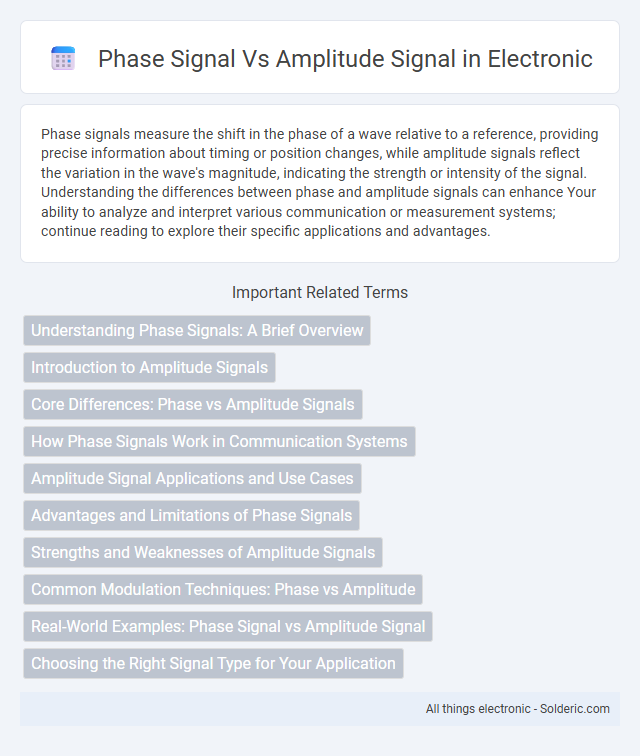Phase signals measure the shift in the phase of a wave relative to a reference, providing precise information about timing or position changes, while amplitude signals reflect the variation in the wave's magnitude, indicating the strength or intensity of the signal. Understanding the differences between phase and amplitude signals can enhance Your ability to analyze and interpret various communication or measurement systems; continue reading to explore their specific applications and advantages.
Comparison Table
| Feature | Phase Signal | Amplitude Signal |
|---|---|---|
| Definition | Variation in the phase angle of the carrier wave | Variation in the amplitude (strength) of the carrier wave |
| Modulation Type | Phase Modulation (PM) | Amplitude Modulation (AM) |
| Signal Stability | More resistant to noise and signal degradation | More susceptible to noise and interference |
| SNR Performance | Higher Signal-to-Noise Ratio (SNR) | Lower Signal-to-Noise Ratio (SNR) |
| Complexity | More complex modulation and demodulation | Simple modulation and demodulation |
| Applications | Digital communication, wireless transmission, GPS | AM radio, broadcasting, analog TV |
| Bandwidth Efficiency | Better bandwidth efficiency | Lower bandwidth efficiency |
Understanding Phase Signals: A Brief Overview
Phase signals represent the position of a waveform relative to time, crucial for synchronizing communication systems and controlling signal timing. Unlike amplitude signals that vary in magnitude, phase signals maintain constant amplitude but shift in phase angle, enabling precise detection of signal changes. Understanding how phase signals carry information allows you to optimize data transmission and improve system reliability in applications like radar, GPS, and wireless communication.
Introduction to Amplitude Signals
Amplitude signals represent information through variations in the signal's amplitude while maintaining a constant frequency and phase. This method is commonly used in amplitude modulation (AM) where the strength of the carrier wave varies in proportion to the input signal's amplitude. Amplitude signals are crucial in communication systems for transmitting audio, video, and data over radio frequencies.
Core Differences: Phase vs Amplitude Signals
Phase signals encode information by varying the phase of a carrier wave, making them highly resistant to noise and ideal for coherent communication systems. Amplitude signals convey data through changes in the wave's amplitude, which is simpler to implement but more susceptible to signal degradation and interference. The core difference lies in phase modulation's ability to maintain signal integrity versus amplitude modulation's vulnerability to amplitude fluctuations.
How Phase Signals Work in Communication Systems
Phase signals in communication systems encode information by varying the phase of a carrier wave relative to a reference signal, enabling efficient data transmission through phase modulation techniques such as PSK (Phase Shift Keying). These phase variations represent different data symbols, providing resilience against amplitude noise and improving signal integrity over long distances. Phase modulation is widely used in digital communications, including satellite links and wireless networks, due to its robustness and spectral efficiency compared to amplitude-based signaling.
Amplitude Signal Applications and Use Cases
Amplitude signals are extensively utilized in communication systems like AM radio broadcasting, where variations in amplitude convey audio information over long distances. In medical diagnostics, amplitude modulation is integral in ultrasound imaging, enhancing tissue differentiation and enabling precise visualization. Your ability to leverage amplitude signal properties facilitates efficient signal transmission and accurate data interpretation across diverse technology sectors.
Advantages and Limitations of Phase Signals
Phase signals offer high sensitivity to changes in frequency and time delay, making them ideal for applications such as radar, communication systems, and signal processing where precise timing and synchronization are critical. Their main advantage is robustness against amplitude variations and noise, allowing more reliable data transmission compared to amplitude signals. However, phase signals can suffer from phase ambiguity and require complex demodulation techniques, which may increase system complexity and cost.
Strengths and Weaknesses of Amplitude Signals
Amplitude signals offer straightforward implementation and compatibility with analog devices, making them cost-effective for simple communication systems. However, they are highly susceptible to noise and signal degradation over long distances, which adversely affects signal integrity and limits their reliability in complex environments. The sensitivity of amplitude signals to amplitude variations reduces their effectiveness compared to phase or frequency modulation in high-interference scenarios.
Common Modulation Techniques: Phase vs Amplitude
Phase modulation (PM) encodes information by varying the phase of the carrier signal, offering advantages in noise resistance and efficient bandwidth usage, commonly utilized in digital communication systems like PSK (Phase Shift Keying). Amplitude modulation (AM) changes the carrier signal's amplitude to transmit data, often seen in traditional broadcasting but more susceptible to noise and signal degradation. Techniques such as QAM (Quadrature Amplitude Modulation) combine both phase and amplitude variations, optimizing data throughput and spectral efficiency in modern telecommunications.
Real-World Examples: Phase Signal vs Amplitude Signal
Phase signals are commonly used in GPS systems where the phase of the carrier wave provides precise location data by measuring the time delay of satellite signals. Amplitude signals dominate in analog audio transmission, such as AM radio, where variations in signal strength encode sound information. Industrial machinery often utilizes phase signals in synchronization tasks, while amplitude modulation remains essential for broadcasting and communication systems.
Choosing the Right Signal Type for Your Application
Phase signals offer higher noise immunity and precision, making them ideal for applications requiring accurate timing and synchronization such as radar and communication systems. Amplitude signals provide simplicity and ease of detection, suitable for basic audio and analog transmission tasks where signal strength is critical. Your choice between phase and amplitude signals depends on the balance between precision needs and system complexity.
phase signal vs amplitude signal Infographic

 solderic.com
solderic.com